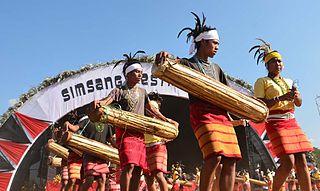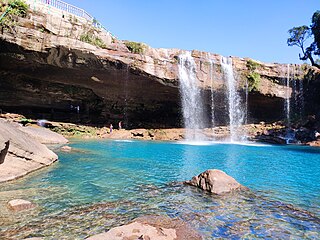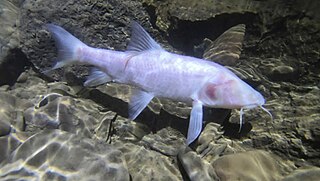
Meghalaya is a state in northeast India. Meghalaya was formed on 21 January 1972 by carving out two districts from the state of Assam: (a) the United Khasi Hills and Jaintia Hills and (b) the Garo Hills. The population of Meghalaya as of 2014 is estimated to be 3,211,474. Meghalaya covers an area of approximately 22,429 square kilometres, with a length-to-breadth ratio of about 3:1.

West Garo Hills is an administrative district in Garo Hills of the state of Meghalaya in India. Tura town is the administrative headquarters of the district. The district occupies an area of 3714 km². In 2011 its population was 643,291. As of 2011 it is the second most populous district of Meghalaya, after East Khasi Hills.

Williamnagar, formerly known as Simsanggre, is the headquarters of East Garo Hills district in the state of Meghalaya in India.

The Garo Hills are part of the Garo-Khasi range in Meghalaya, India. They are inhabited by the Garo people. It is one of the wettest places in the world. The range is part of the Meghalaya subtropical forests ecoregion.

The Meghalaya subtropical forests is an ecoregion of Northeast India. The ecoregion covers an area of 41,700 square kilometers (16,100 sq mi), and despite its name, comprise not only the state of Meghalaya, but also parts of southern Assam, and a tiny bit of Nagaland around Dimapur and adjacent Bangladesh. It also contains many other habitats than subtropical forests, but the montane subtropical forests found in Meghalaya is an important biome, and was once much more widespread in the region, and for these reasons chosen as the most suitable name. The scientific designation is IM0126.
Benarat Cavern is a cave system situated in Mount Benarat at the northern end of Mulu National Park in Malaysia. As of 2011, it is the third-longest known cave in Asia at 50 km.
Krem Liat Prah is the longest natural cave in South Asia.

Cave research, encompassing the study of speleology and biospeleology, is still in its infancy in India. Although there are thousands of caves in India, research expeditions occur in few states. The Siju Cave in Meghalaya is the first limelighted natural cave from India. Several studies were carried out in this cave in the early 20th century. The Kotumsar Cave in Central India is one of the most explored caves of India, and biologists have classified many types of cavernicoles, i.e. trogloxenes, troglophiles and troglobites, from this cave.

The Belum Caves, located in Nandyala district of Andhra Pradesh's Rayalaseema region, is the second largest cave system on the Indian subcontinent, known for its speleothems, such as stalactite and stalagmite formations. The Belum Caves have long passages, galleries, spacious caverns with fresh water and siphons. This cave system was formed over the course of tens of thousands of years by the constant flow of underground water from the now-disappeared river Chitravathi. The cave system reaches its deepest point at the point known as Pataalaganga. Belum Caves have a length of 3,229 m (10,593.8 ft), making them the second largest caves on the Indian Subcontinent after the Krem Liat Prah caves in Meghalaya. It is one of the centrally protected Monuments of National Importance.

Nohsngithiang Falls is a seven-segmented waterfall located 1 kilometre (0.62 mi) south of Mawsmai village in East Khasi Hills district in the Indian state of Meghalaya. The water falls from a height of 315 metres (1,033 ft) and has an average width of 70 metres (230 ft). making it one of the tallest waterfalls in India.

The Hynniewtrep National Liberation Council is a militant organization operating in Meghalaya, India. It claims to represent the Khasi-Jaintia tribal people, and its aim is to free Meghalaya from the alleged domination of outsiders from the Indian mainland. It was proscribed in India on 16 November 2000, but the ban was later lifted, before banning it again in 2019.
Williamson Ampang Sangma, a Garo leader, former Chief Minister of Meghalaya, twenty-first state of India on 21 January 1972. He was also the first ever Governor of Mizoram among the Garos in 1989.

West Jaintia Hills is an administrative District in the state of Meghalaya in India. The united district was created on 22 February 1972 and occupied an area of 3819 km2. It had a population of 272,185. The district is part of the Meghalaya subtropical forests eco-region. With the bifurcation of the erstwhile Jaintia Hills District into East and West Jaintia Hills Districts, West Jaintia Hills District came into existence on 31 July 2012 with its headquarters at Jowai. Jowai is the host of all the heads of important governmental offices and establishments, educational institutions, hospitals, banking institutions, etc.

The Insurgency in Meghalaya is a frozen armed conflict between India and a number of separatist rebel groups which was taking place in the state of Meghalaya. The Insurgency in Meghalaya is part of the wider Insurgency in Northeast India, and was fueled by demands of the Khasi, Synteng and Garo people for a separate state.

Siju Cave, also known as Bat Cave in English, is located in the North East Indian state of Meghalaya near the Napak Lake and Simsang River game reserve. It is a limestone cave and is famous for its stalagmites and stalactites.
Krem Synrang Pamiang is a cave located in the Jaintia Hills district of Meghalaya state, India. It is the third longest cave of India, with 14,157 m of surveyed passage.
The Meghalayan age is the name given in 2018, by the International Commission on Stratigraphy, to the current age or latest geologic age – or uppermost stage of the Quaternary. It is also the upper, or latest, of three subdivisions of the Holocene epoch or series. This way of breaking down time is based only on geology; for example it is unrelated to the three age system of historical periods into which human development is sometimes divided.
Bullita Cave, also known as Burkes Backyard Cave, is a cave located in Gregory National Park of the Northern Territory, Australia. It is one of the longest surveyed caves in both Australia and the world.
Mawmluh Cave is a maze cave in the state of Meghalaya in northeast India. At 7.2 km in length, it is the fourth longest cave in the Indian subcontinent. The cave, which has several entrances, has formed at the junction between an early Eocene dolomite and a sandstone formation. It contains numerous stalactites, stalagmites, columns and drapes, collectively termed speleothems.

Neolissochilus pnar is a species of subterranean cyprinid in the genus Neolissochilus. It is the largest known subterranean fish, a title formerly held by the blind cave eel.














